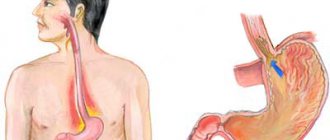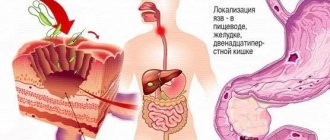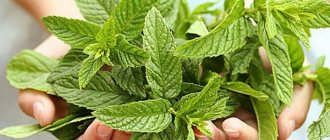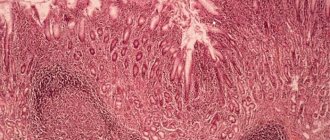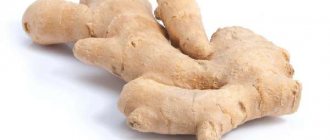What is gastric achylia
Achylia of the stomach is a violation of the production of gastric juice, leading not only to digestive problems, but also to other disorders
Gastric achylia is a pathology characterized by a failure in the production of the enzyme (pepsin) necessary for the breakdown of proteins. Before the development of the disease, another condition occurs - achlorhydria, during which hydrochloric acid is not produced. Thus, achilia is understood as the absence of secretions - hydrochloric acid and enzymes.
Digestion is one of the main processes of the human body. Violation of this function leads to problems in other systems. The body does not receive the necessary nutrients, so it is depleted.
The danger of the condition is associated with a long course of the disease without clinical signs. The slightest suspicion of the development of the disease is a reason to seek medical help.
Achylia also occurs in newborns, but in the first 2 weeks of life the condition is considered normal.
Mechanism of disease development
The main function of the stomach is to digest food. Periodic contractions and relaxations of the walls of the organ contribute to grinding and further movement of pieces of food into the intestines. This process is impossible without the participation of hydrochloric acid and special enzymes. These are the main components of gastric juice. The active release of enzymes begins the moment a person smells the aroma of food. Under the influence of gastric juice, denaturation and breakdown of proteins and fats and hydrolysis of carbohydrates occur. If for some reason hydrochloric acid and enzymes cease to be released, the digestion process stops. The breakdown of carbohydrates, which began in the oral cavity, continues. But proteins and fats remain unchanged, the body does not absorb them. As a result of the described process, food penetrates the intestines very quickly. Here it is not digested, but rots and “ferments.” Hydrochloric acid also disinfects food. It enters the intestines without pathogenic microorganisms. If acid production is impaired, various bacteria can enter the intestines along with food, causing intestinal infections.
This clinical picture fully characterizes the development of a disease such as achylia. This is a serious pathological condition caused by a violation of the secretory activity of the stomach. The digestion process is one of the most important in the human body. Therefore, a violation of any of its stages affects the work of other organs. The insidiousness of this disease is that it can be asymptomatic for a long time. However, doctors identify a number of signs by which the disease can be recognized at an early stage.
Types of pathology
The cessation of hydrochloric acid production may be the result of damage to the cells performing this function, or to more complex processes occurring at the neurohumoral level. Therefore, there are several types of achilia:
- functional;
- organic;
- idiopathic;
- histamine-resistant.
The emergence of a functional form occurs when gastric secretion is disrupted. Cells can produce a certain secretion, but due to the lack of hormonal influence, they temporarily stop their activity.
In a healthy person, when food enters the stomach, hormones are produced. They affect the secretion of pepsinogen and hydrochloric acid, which leads to their activation. Exposure to pathological factors leads to disruptions in hormonal regulation, resulting in disturbances in the functioning of gastric cells.
Functional form is variable. At different times, acidity may increase or be restored to normal levels.
The organic type occurs as a result of damage to the mucosa in the part of the organ that contains the glands. The cause of the condition is the influence of pathogenic factors. With mild degrees, normalization of acidity and cell restoration are possible. Irreversible changes are characteristic of extensive lesions and the chronic type of the disease.
With a mild course of organic achylia, a certain number of intact cells remain. It is these parts of the gastric mucosa that can do their job normally.
The idiopathic form of achylia occurs in the absence of mucosal damage. The pathology is not associated with disruptions in hormonal function. The main reason is the failure of the glands, which affect the production of enzymes and hydrochloric acid. The condition is congenital, so the secretion of gastric juice is not normal in patients.
If the formation of acid and enzymes does not occur, but stimulation with histamine occurs, the pathology is histamine-resistant. In the idiopathic type of the disease, there is no sensitivity of the cells; in the organic form, the achylia glands do not respond to histamine stimulation, as they are completely destroyed.
Reasons for development
Achilia is a complete violation of the secretion of gastric juice, and occurs as a result of exposure to the following factors on the human body:
- poor nutrition with a predominant consumption of complex carbohydrates and other foods that require a lot of effort to digest;
- poor chewing and dry food;
- long period of fasting;
- smoking tobacco products;
- stress or prolonged psycho-emotional stress;
- hormonal imbalance;
- exposure to vibration;
- constant exposure to high temperatures;
- autoimmune damage to secretory cells;
- metabolic disease;
- long-term use of medications.
Achilia develops as a result of complete or partial removal of the stomach. This operation is performed for severe peptic ulcers, perforation or bleeding. Organ resection is possible for cancerous tumors or polyps. Untreated gastritis or inflammatory diseases of other organs of the gastrointestinal tract can cause the development of pathology.
Often achylia occurs as a result of autoimmune damage to stomach cells.
Causes and risk factors
Many factors lead to the development of achylia:
- stress and overexertion;
- longer fasting;
- swallowing food in chunks without chewing;
- dry food;
- smoking;
- incorrect diet: consuming large amounts of carbohydrates with a high glycemic index (sweets and fresh baked goods) and refractory fats (beef and lamb);
- alcohol consumption;
- long-term use of medications: diuretic, neuroleptic, antihypertensive and antiparkinsonian;
- frequent vibration or overheating (during work in production);
Pathology can occur in pregnant women, since this period is a heavy load for many body systems.
A risk factor is also the presence of deficiency:
- cardiac;
- renal;
- pituitary;
- respiratory (chronic type);
- hepatic.
The formation of achylia also occurs against the background of the progression of certain diseases. These include:
- diabetes;
- thyrotoxicosis (hyperthyroidism) is a pathology in which the production of thyroid hormones increases;
- superficial gastritis;
- inflammation in autoimmune diseases.
Gastritis is a common cause of achylia
Damage to the mucous membrane of the organ and the appearance of organic type achylia occurs under the following circumstances:
- there is no treatment for functional achylia;
- chronic diseases of the intestines, bile ducts, liver and pancreas develop;
- the atrophic form of gastritis progresses;
- Chronic types of gastritis occur over a long period of time;
- stomach cancer develops; in rare cases, achylia occurs in advanced stages of the formation of malignant tumors of other organs.
Young people are characterized by achylia, which occurs as a result of a failure of neurohumoral processes or against the background of inflammation. In older patients, the disease often occurs against the background of stomach cancer.
Symptoms
With short-term disorders of gastric secretion, the compensatory functions of the body are activated. Some of the digestive functions are taken over by the duodenum and pancreas, but this does not bode well for the patient - the pathology proceeds secretly.
If achylia lasts for a long time, the failure affects neighboring organs. Pathological changes appear in the tissues, the evacuation and motor functions of the intestines and stomach are disrupted. The following symptoms occur:
- belching with an unpleasant aftertaste;
- intolerance to certain foods: caviar, eggs, crayfish, meat;
- decreased appetite;
- bloating;
- feeling of a full stomach even after eating small portions of food;
- increased gas formation.
Often, patients with gastric achylia show a tendency to consume marinades, lemons and other acidic foods.
If achylia occurs against the background of decreased secretion of the pancreas, then the nature of the feces changes - they become discolored and abundant. In addition, they contain undigested protein fiber and a large amount of fat. Increased diarrhea occurs due to lack of gastric digestion. The situation is aggravated by undigested food particles, which increase peristalsis.
Symptoms of the disease
A slight disturbance in the secretion of hydrochloric acid is compensated by the work of other organs of the digestive tract, which ensure sufficient digestion of food. But a long-term absence of digestive enzymes causes significant digestive upset with impaired motility and evacuation function of the stomach.
Ahilia provokes the development of symptoms in the patient such as:
- nausea;
- poor appetite;
- aversion to protein foods;
- frequent belching;
- rotten breath;
- coating of the tongue with a white coating;
- flatulence and intestinal colic;
- constant diarrhea;
- disruption of the normal functioning of the pancreas.
Diagnostics
To make a correct diagnosis, the information obtained during examination and collection of complaints is not enough. The following research methods are used:
- PH-metry. It is used to measure acidity levels. To obtain data, a special probe with a sensor is inserted into the stomach.
- Acidotest. The technique is also aimed at obtaining information about the level of acidity. The patient takes a tablet with an indicator. It is released in the stomach and excreted from the body in colored urine.
- Examination of feces. A stool test confirms the presence of undigested pieces of food.
- Fibrogastroscopy. A probe is used to examine the gastric mucosa and determine its condition. It is possible to take a tissue sample for study.
- Contrast radiography. A solution is injected into the stomach, which appears during diagnosis. Using the method, neoplasms are identified and disturbances in the relief of the organ mucosa are detected.
Fibrogastroscopy is a method that allows you to assess the condition of the gastric mucosa during the development of achylia
Treatment
The choice of treatment tactics depends on the form of the disease. The goal of therapy is to stimulate the production of enzymes and hydrochloric acid. It is important to treat the underlying pathology that led to the onset of the disease.
Functional form
During therapy for functional achylia, remission can be achieved. To do this, adhere to the following recommendations:
- avoid stress and conflict situations;
- exclude overeating;
- provide adequate sleep;
- normalize the daily routine and rest: walking in the fresh air and playing sports are beneficial;
- get rid of harmful addictions - drinking alcohol and smoking;
- fractional meals are administered (5–6 times a day);
- chew food correctly.
If an infection is detected, antibacterial and antiviral therapy is prescribed. If the culprit of the failure of the secretory function of the stomach is depression, then psychotherapy sessions are carried out.
An important area of treatment is stimulation of gastric secretion. For this purpose, the following drugs and products are prescribed:
- rosehip decoction;
- tinctures from plants: wormwood, plantain, St. John's wort, thyme;
- fresh juices from fruits and vegetables (necessarily diluted): lemon, cabbage and tomato;
- tablets with succinic and citric acid;
- Essentuki mineral water (numbers 4 and 17);
- gentian extract and tincture.
Organic form
Treatment of the organic form of pathology, in which residual digestive functions are preserved, is similar to the previous case. Other methods are necessary if there is no sufficient level of secretion:
- It is allowed to eat only processed food (thermal and mechanical);
- for diarrhea, a solution of hydrochloric acid is prescribed;
- To strengthen the body and speed up the recovery process, multivitamin complexes are prescribed.
Enzyme agents are used for intestinal problems:
- Pancreatin;
- Creon;
- Panzinorm;
- Panzikam;
- Mezim Forte;
- Micrasim;
- Vestal;
- Gastenorm.
Anabolic drugs are used to restore the gastric mucosa:
- Retabolil;
- Nerobol.
Medications in the photo
Creon will help the patient during gastric achylia Pancreatin normalizes the digestion process Mezim Forte improves the absorption of proteins, carbohydrates and fats Festal facilitates the digestion of carbohydrates, proteins and fats thanks to special enzymes contained in the medicine
How to treat?
Therapy for achylia should be comprehensive and aimed at eliminating the main symptoms of the disease and the causes that could provoke it. For this purpose, medications are used to compensate for the missing hydrochloric acid. When cells partially lose their secreting function, they try to preserve the remaining exocrine components. If the pathology is functional in nature, then the insufficiency of gastric juice is reversible. In this case, the patient should get rid of stress, normalize diet and eliminate bad habits.
In the treatment of achylia, alternative medicine is often used.
Functional form
Treatment of this type of achylia is aimed at eliminating the factors that provoke the development of the disease. To get rid of Helicobacter pylori, antibacterial drugs are used. It is also important to start eating in small portions, but often, and also to eliminate the influence of stress. Juices from fresh vegetables and fruits will help significantly increase the production of hydrochloric acid. Particularly effective are tomato, lemon or cabbage. Mineral waters and rosehip decoction, which should be consumed before meals, will be useful.
Companion diet
Patients adhere to the Pevzner diet (table No. 2). Food is taken in small portions, thermally processed foods are consumed - by boiling, baking, stewing, steaming.
It is recommended to dilute juices with water. Hard and raw vegetables should be served in the form of puree, while soft ones do not need to be chopped.
Diet during the development of the disease is based on the following principles:
- fluid intake - about 1.5 liters per day;
- proteins - approximately 80–100 g;
- fats - about 80–100 g;
- carbohydrates - approximately 200–400 g;
- salt - no more than 8–14 g;
- calorie norm is 1900–2500 kcal.
Products allowed for the patient:
- tea;
- baked goods (dried) from low-fat dough;
- chopped greens: parsley, dill;
- oil: butter and refined vegetable oil;
- sweets: jam, honey, marshmallows, sugar, marshmallows;
- for compote - chopped dried fruits;
- vegetables: potatoes, zucchini, pumpkin, beets, tomatoes, carrots, green peas;
- caviar;
- offal: liver, lungs;
- meat: lean veal, turkey, chicken;
- additives to improve taste: cinnamon, bay leaf, vanillin;
- any lean fish.
What should a sick person not eat? Prohibited products are represented by the following food components:
- hard boiled eggs;
- ice cream;
- cereals: corn, pearl barley, barley, millet;
- garlic;
- chocolate;
- mustard;
- baking;
- fresh bakery;
- mushrooms;
- onion;
- pepper;
- berries: currants, figs, raspberries, gooseberries, dates;
- fats: lamb, pork, beef, solid vegetable;
- kvass;
- horseradish;
- dairy products: salty and very sour.
Photo gallery of prohibited products
Onions must be avoided during the development of achylia. Pepper strongly irritates the gastric mucosa. It is recommended to exclude chocolate from the diet of a patient with gastric achylia. Pork is a fatty product, so it puts a lot of strain on the patient’s stomach.
Consequences and complications
The main mistake patients make is the lack of treatment, which is why the disease develops. The functional form passes into the organic stage. Prolonged course of organic achylia can cause complications leading to pathological changes in the gastric mucosa and disruptions in digestion.
The following consequences of the disease are observed:
- transition of atrophic gastritis to the chronic type;
- failure of the intestines, pancreas and liver;
- stomach cancer;
- development of anemia (anemia) – decrease in hemoglobin in the blood.
Clinical picture
The clinical picture of functional gastric achylia may not appear for a long time, especially with good compensatory function of the pancreas and intestines. The patient's complaints are nonspecific: vague pain in the epigastric region, especially after eating large quantities of food; fast fatiguability; increased irritability. Achylia of the stomach in such cases is detected by chance.
With organic achylia of the stomach, a number of objective symptoms appear associated with changes in the functions of the stomach and involvement of the liver and bile ducts in the pathological process. Disturbances in the biliary tract system, together with pancreatic insufficiency, manifest as steatorrhea, creatorrhea and polyfecalia, cause intestinal dyspepsia, and increase fermentation and putrefactive processes. In the absence of hydrochloric acid and pepsin, exogenous infection penetrates the intestines, dysbacteriosis and infectious diseases develop. Pain in the epigastric region can be explained by a circulatory disorder in the wall of the stomach in the form of venous stasis, mainly in the area where the intragastric nerve ganglia are located (P. N. Stepanov). Disruption of hydrolytic processes, increased absorption of large fragments of protein molecules in the inflamed small intestine with reduced barrier function of the liver lead to the development of sensitization of the body (O. L. Gordon); Perhaps this explains intolerance to eggs, fish, crayfish, milk and some other foods. Achylia of the stomach is often accompanied by weight loss, decreased body resistance, and anemia due to impaired absorption of vitamin B12, iron and copper. Due to impaired absorption of vitamins and mineral salts, pellagra, osteoporosis, and ariboflavinosis may develop.

